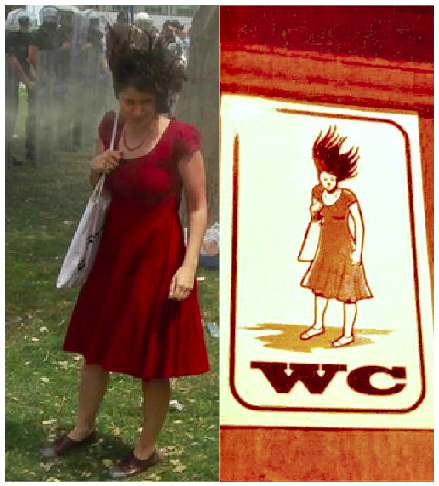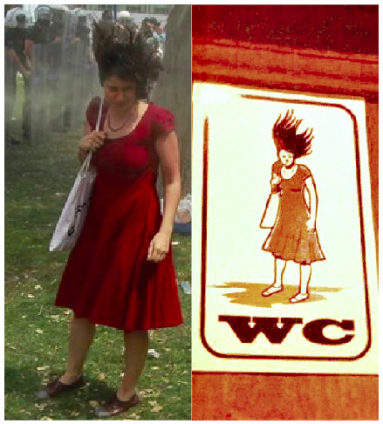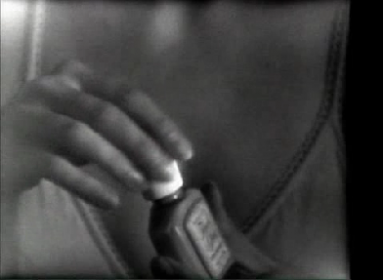What's going on in beauty this week, from head to toe and everything in between.
From Head...
Crop top: Cristen and Caroline nail it again with their podcast on what short hair symbolizes on women. (Bonus: You'll learn the real story behind Mia Farrow's pixie cut.)
...To Toe...
Toeing the line: Note to those hoping to deploy fraud to avoid paying full price for a pedicure, as was the case with a Connecticut woman this week who stopped the pedicure midway through and insisted on paying only $10: Dash out on the early side. "Police observed the final coat of polish on Parker’s nails and asked her to pay the full $22, which she refused, according to police." She was charged with sixth-degree larceny for theft of services.
...And Everything In Between:
Lady in red: Protests in Turkey and an icon of femininity colliding with tear gas combine to make a "hers" restroom sign in a university town in central Anatolia.
Working women: Along with the increase of women in India entering the paid urban workforce comes a demand for professional wares. Enter Unilever, with its new collection through the Lakme line, called 9 to 5.
Little yellow bottle: Clinique's Dramatically Different Moisturizing Lotion = The New Coke of beauty products?
Humpty hump: A Dubai company is entering the beauty sector with a product that truly hasn't been seen before in most of the world: camel milk beauty products. And naturally, the company name is Camelicious.
Dress for success: I thought it was a relatively new strain of feminism that saw women championing conventional markers of femininity (dresses, makeup, etc.) as a way of proclaiming feminist identity while holding on to those icons. Turns out it's not new at all: The leading British suffrage organization "used women’s fashionable dress to offer an overtly political argument: women could be both fashionable English women and militant Suffragettes."
AAthletes: "For the modern athlete, the question isn't whether breasts get in the way—it's a question of how to compete around them." (via Caitlin)
Oil me up: Can you use oils as sunscreen? The answer seems to be not really, though Venusian Glow reports positively on using raspberry seed oil, with an SPF of 28 to 50, placing it within the recommended SPF zone. (Other testers, not so much.) What's more probable is that research in this direction will come into play in creating a natural sunscreen, as indicated by research in India. Good thing too, since the glitter sunscreen market has been cornered already. Also relevant: What's the difference between sunscreen and sunblock?
On modesty: I'm intrigued by the idea of this woman's "modesty experiment," in which a feminist with (apparently) no religious beliefs that dictate modesty covered her hair, shunned makeup, and dressed modestly for nearly a year. The concept of modesty is complicated and I'm hoping that the writer, Lauren Shields (who blogs here), untangles much of that complication in her forthcoming book. But as Katie J.M. Baker points out at Jezebel, as it stands now, the experiment feels like it's missing something. The conclusions in the Salon piece are a tad pat, and the blog's emphasis on how glad she is to have ended the experiment seems uneven. Fingers crossed for a more meditative analysis to come; I trust it's there.
"Formulated with...": From a cosmetic chemist blog, a snapshot of "weasel words" the industry uses to imply claims that can't be stated directly. (Also, pssst: If you're into cosmetics science, pre-order The Beauty Brains' newest book, provocatively titled It's OK to Have Lead in Your Lipstick.)
Race daze: One of the things you hear over and over again from athletic women is how focusing on what their bodies can do rather than what their bodies look like is like a (temporary) wormhole out of self-objectification. Fit and Feminist's examination of race photos—the photos of sweaty, determined women who are focusing on exertion and crossing a finish line instead of controlling a goofy facial expression—considers what happens when those two ways of being collide.
Sniffer: The biggest factor men consider when choosing a cologne is, apparently, whether their partner likes it (which makes sense if worn according to a lovely guideline I once read—that the correct amount to wear was just enough so that a person embracing you would catch a whiff, and no one else). Any guesses as to what the biggest factor women consider is?
Make Up—Make Down, Sanja Ivekovi?, 1976
Make Up—Make Down: The private ritual of cosmetics is part of its draw for many women—but that's just it, it's private. In her 1976 video piece Make Up—Make Down, Croatian artist Sanja Ivekovi? lets us become privy to the intimacy of someone else's ritual: the heavy breath, the focus on the decolletage, the ritualistic opening of makeup jars. It's particularly interesting given that Ivekovi? created the piece when Croatia was part of the former Yugoslavia—a time and place that cast makeup under a light of suspicion. (Thanks to Sarah Nicole for the link.)
Sitting pretty: Samvid has a nice mini-roundup of art that asks larger questions about beauty—including the recent "Barbie" designed to mimic the average 19-year-old woman's measurements.
Reproductive rights: "My body my choice" can be extended to pregnant women in dealing with comments from strangers—specifically male strangers, for this guest writer at Feminist Figure Girl.
Just my size: It's interesting to me how many of my female friends (and myself) have no problems saying that they have a definite body type they prefer in male partners—tall, chubby, muscular, skinny, whatever. Honestly, it's the kind of talk that would get me up in arms were a man to say it, which I'll admit is sexist of me; the more I read stories from men with body image concerns, the more it'll sink in that it's the same damn thing, but for now the knee-jerk reaction isn't the same. Perhaps it would be if there were "No Fat Dudes" baby tees? Whatever the case, this piece about being a lady "chubby chaser" is interesting, and makes me wonder about how much stock women place in being comparatively smaller than their partners.
This has potential to be cool: Online video makeup and hair consultations.
This has potential to be terrorizing: cosmetics chain partnering with facial recognition tech firm to detect customers' moods and allow them to send out personalized offers. (Now anti-drone apparel can go masstige!)
Bodily integrity: I can't think of a lovelier idea for helping sex workers connect with each other—and with their own bodies—than the community-organized day of spa and wellness treatments called "Whores' Bath."
Stripped: Theoretically I like the concept of nudity-as-liberation, but outside of the occasional nudist colony treatise (ugh) most of what you see on the matter focuses on the "is striptease/burlesque feminist?" question (to which I'd say, whatever). But! Gala Darling's report of a confidence class in which every participant shimmied naked down a runway is revelatory.
"I don't see my body as a canvas": I'm still pondering all the fantastic responses I got when I asked readers about why they wore makeup—and one particularly insightful response comes from Tatiana at her own blog.
Color me Edith: The Downton Abbey makeup line now exists, and now we can all try to have Lady Mary's skin and totally fail.
Ugly I: Several searing insights in this piece on the possibility of reclaiming "ugly"—made all the sharper when she points out to the reader that people's instincts are to discount the mere possibility that the writer might be ugly...which is exactly what I did when I saw her picture. Why does ugly seem so untouchable, as though it's the worst possible thing someone could be? (Still, I'm not as sure as the writer is here about the relationship between beauty and, say, humor: She wonders if she'd still be a stand-up comic were she conventionally beautiful, whereas I've heard plenty of other women in comedy wonder if the best way to get booked is to be hot.") (Thanks to Joy for the link!)
Ugly II: There are some wince-worthy parts of this essay on "ugly privilege" (since when is it only beautiful women who are sexually assaulted?), but it's an interesting illustration of the dynamics that come into play in female friendships where beauty is concerned. It's deeply uncomfortable stuff to talk about, particularly for feminists (okay, particularly for this feminist), so props for touching on a difficult topic, even if misguided. (Thanks to Rachel for the link!)
On "inner beauty": "The problem with the 'beauty is an attitude' logic is that it places all the blame and responsibility on women." Sing it, sister. The smartest critique of this line of thinking that I've ever read.
Anon was a woman: Why aren't models usually credited by name in fashion magazines? On illustrative shots it's one thing, but a fashion shoot is demanding of all laborers involved, and while it's routine to credit hairstylists, manicurists, etc., you rarely see the models acknowledged. Emily at The Closet Feminist raises the question and makes some excellent points. (Side note: In all my years copy editing magazines, mostly fashion-oriented, my only client that regularly credited models by name was a men's magazine.)


